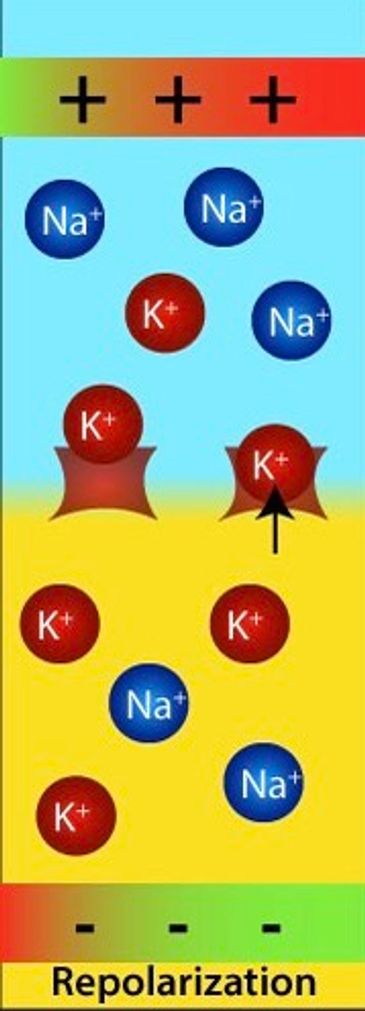Youth STEM Initiative's Interactive Science Learning Labs
Laboratory Simulations
Welcome to Youth STEM Initiative's collection of laboratory simulations provided through scientific applications such as PhET Simulations and Visible Body. Learn about a wide variety of topics in science interactively from action potential firing in neurons to the mechanisms of natural selection in this section!
Mechanism of an Action Potential
The 3 Steps of An Action Potential

DEPOLARIZATION
When an action potential reaches the axon it causes the cell to depolarize, making it more positive on the inside and more negative on the outside. This difference in electronegativity is caused by an influx of sodium ions into the cell, which are positively charged. As a result of sodium ions entering the cell through voltage-gated sodiu
When an action potential reaches the axon it causes the cell to depolarize, making it more positive on the inside and more negative on the outside. This difference in electronegativity is caused by an influx of sodium ions into the cell, which are positively charged. As a result of sodium ions entering the cell through voltage-gated sodium ion channels (NaV), the inside of the neuronal axon becomes more positive while its outside becomes more negative.

REPOLARIZATION
During Repolarization, potassium ions exit the cell through voltage-gated potassium ion channels (KV). This resets the difference in charge across the membrane between the inside and outside of the neuron. Specifically, the neuronal membrane's potential becomes negative again while the outside becomes positive relative to the inside. In t
During Repolarization, potassium ions exit the cell through voltage-gated potassium ion channels (KV). This resets the difference in charge across the membrane between the inside and outside of the neuron. Specifically, the neuronal membrane's potential becomes negative again while the outside becomes positive relative to the inside. In the heart, Repolarization allows the cardiac ventricles to depolarize again and contract to pump blood when the next action potential arrives.

HYPERPOLARIZATION
HYPERPOLARIZATION
As potassium ions continue to exit the cell through KV channels, the membrane potential temporarily becomes more negative than the resting potential, which is around -70 mV, as it reaches -80 mV or lower. The reason for this is that K⁺ channels close slowly, which allows extra K⁺ ions to exit the neuron. Following this, the resting membra
As potassium ions continue to exit the cell through KV channels, the membrane potential temporarily becomes more negative than the resting potential, which is around -70 mV, as it reaches -80 mV or lower. The reason for this is that K⁺ channels close slowly, which allows extra K⁺ ions to exit the neuron. Following this, the resting membrane potential is restored by the pumping of K⁺ into the cell and Na⁺ out with the help of the sodium-potassium pump (Na⁺/K⁺ ATPase).
Graphical Representation of an Action PotenTIAL

RESTING (5)
• K⁺ leak channel is always OPEN
• K⁺ voltage-gated channel CLOSED
• Na⁺ voltage-gated channel CLOSED
• Na⁺ ligand-gated channel CLOSED
STIMULUS --> EPSP: Excitatory Post-Synaptic Potential (1)
• K⁺ leak channel is always OPEN
• Na⁺ ligand-gated channel OPEN
• Na⁺ voltage-gated channel CLOSED
• K⁺ voltage-gated channel CLOSED
DEPOLARIZATION: Action Potential Rise (2)
• K⁺ leak channel is always OPEN
• Na⁺ ligand-gated channel CLOSED
• Na⁺ voltage-gated channel OPEN
• K⁺ voltage-gated channel CLOSED
REPOLARIZATION: Action Potential Fall (3)
• K⁺ leak channel is always OPEN
• Na⁺ ligand-gated channel CLOSED
• Na⁺ voltage-gated channel CLOSED
• K⁺ voltage-gated channel OPEN
HYPERPOLARIZATION: Refractory Period (4)
• K⁺ leak channel is always OPEN
• Na⁺ and K⁺ pumps remain open to allow Na⁺ and K⁺ to return to their original places.
Gene Expression Simulation
How Our Genes Are Expressed
The Central Dogma of Molecular Biology
The Central Dogma explains the process by which the instructions in DNA are converted into a functional protein through Transcription (DNA → RNA) and Translation (RNA → Protein).
This dogma embodies the expression of our genes to produce the proteins that keep us alive and functioning, and helps explain key genetic concepts like heredity, gene regulation, and genetic variation. Transcription regulates the turning on/off of genes, in which a gene's sequence of DNA nucleotides is transcribed to produce an mRNA molecule with a complimentary genetic code; meanwhile, Translation is the process in which the mRNA code is translated into a sequence of amino acids by corresponding tRNA molecules that each carry an amino acid to the mRNA molecule, ultimately forming a polypeptide with a particular conformation that corresponds to the function it serves.
Through these two sequential processes genes can be expressed and translated into protein, influencing our vital functions, behaviour, cognition, and more.

Natural Selection Simulation
Evolution by Natural Selection
Natural Selection is the process by which certain heritable traits are selected for on the basis of their ability to enhance the survival/reproduction of an organism. As a result of this, the frequencies of certain genes and traits increase while others decrease over time in a population. The factors that drive natural selection include environmental pressures such as climate change, resource availability, the existence of predators or pathogens, competition within and between species, and sexual selection. Together, these variables determine which traits are favourable and are therefore more likely to be passed on to future generations.

Methods of Injection
The 4 Types of Injections Explained

Intramuscular
Intramuscular
Intramuscular
Intramuscular injection is a method used for delivering medication deep into muscle fibre. Inserted at a 90° angle, the medication is swiftly and efficiently absorbed into the bloodstream. This technique is often used for vaccinations, antibiotic injections, and other therapies that require an immediate or sustained physiological effect.

Subcutaneous
Intramuscular
Intramuscular
A subcutaneous injection delivers medication at a 45° angle into the fatty tissue just underneath the skin, called the subcutaneous layer (sub means "under" and cutaneous refers to skin). This type of injection allows for slower and more consistent absorption. It is commonly used for injecting substances like insulin, anticoagulants, and hormones.

Intravenous
Intramuscular
Intravenous
Intravenous injections deliver drugs directly into the bloodstream at a 25° angle, resulting in instant effects—this is the fastest of the four types of injections. It is commonly used in emergency situations and for hydration. IVs are typically administered in the veins of the upper extremities, which includes the hands and arms, especially the forearms.

Intradermal
Intramuscular
Intravenous
Intradermal injection is the process of injecting medication at a 15° angle into the top layer of the skin (dermal is derived from the Greek derma, which means "skin"). It is usually used for diagnostic purposes such as allergy testing or tuberculosis screening, as it allows for localized reactions to take place. This is the shallowest of the four types of injections.
Blood Types
The Blood Typing Process Demonstrated in 5 stePS
How it works:
◉ 4 blood types: A, B, AB, O (as shown above) with + or - for Rh factor
◉ Each blood type's name comes from the antigen(s) on it. For type A there are A antigens; for type B there are B antigens; for AB there are both A & B antigens; and for O there is no antigen
◉ Each antigen has a corresponding antibody that causes agglutination when bound to it
◉ In blood typing, we observe their reactions to specific (A & B) antibodies in serum, and to Rh factor to determine whether it's + or -
The pH Scale
Acidic, Alkaline, and Neutral pH

ACIDIC (pH < 7)
ALKALINE (pH > 7)
NEUTRAL (pH = 7)
Acidic substances generally have a pH of less than 7 and release H⁺ ions when in solution, with lower pH (more acidic) substances releasing H⁺ ions more easily. Examples include gastric acid (pH 1), lemon (pH 2), acetic acid (pH 2.4), and battery acid (pH 0).

NEUTRAL (pH = 7)
ALKALINE (pH > 7)
NEUTRAL (pH = 7)
Neutral substances generally have a pH of 7 or around 7 and do not release H⁺ or OH⁻ ions. These substances are neither acidic nor basic as they have an equal balance of H⁺ and OH⁻ ions. A common example is pure water, as well as human blood (albeit it does fluctuate a lot).

ALKALINE (pH > 7)
ALKALINE (pH > 7)
ALKALINE (pH > 7)
Alkaline substances have a pH great than 7 and release OH⁻ ions when in solution, with higher pH (more basic) substances releasing OH⁻ ions more easily. Examples include sodium hydroxide (pH 14), ammonia (pH 11), lyme (pH 12.4), and sodium carbonate (pH 11.5).
Electromagnetism Lab
Molecule Building Lab
Exclusive Access to Visible Body Suite for YSI Members
Youth STEM Initiative
Vancouver, BC, Canada | Seattle, WA, United States
This website uses cookies.
We use cookies to analyze website traffic and optimize your website experience. By accepting our use of cookies, your data will be aggregated with all other user data.